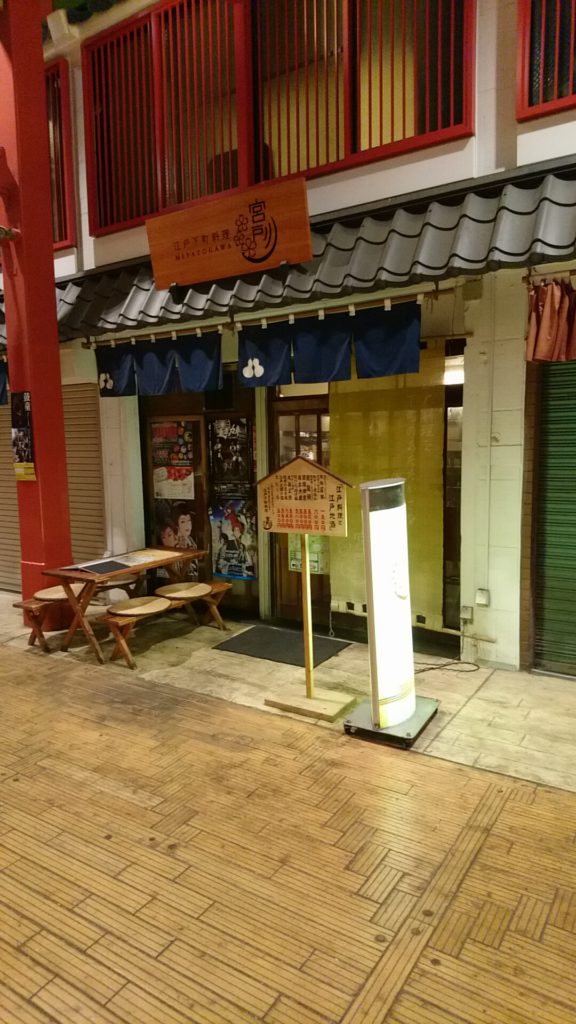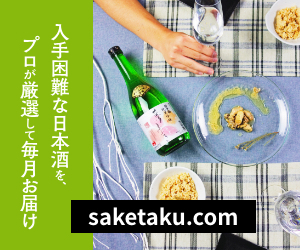- Home
- Report of Delicious Sake Serving Restaurants, My Three Meals, taito
- Enjoyed Edo Sake and Foods at “Miyatogawa”, Asakusa
Enjoyed Edo Sake and Foods at “Miyatogawa”, Asakusa
- 2018/6/23

Good evening.
Thank you very much for visiting this blog.
Today I introduce you a restaurant “Miyatogawa” in Asakusa.
This restaurant serves,
Edo period’s food and Sake as the board says. I got to know this restaurant in February and I had wished to come since then, and I finally made it on that day.
This restaurant locates,
Near the west approach to Sensouji Temple.
Seeing the temple in front, there is a shopping arcade on the left side of the approach. This restaurant is in this arcade.
If you go straight along the arcade to the edge, there is Wins Asakusa. If you go to the right from the approach, which is the opposite of the arcade, there is Asakusa Hanayashiki.
Now, the inside of Miyatogawa is like this.
It was an unusual sunny and hot day even though it was middle of rain season. I got my bicycle’s rear wheel completely flat, and I had to walk 2km to take my bike to get repaired in such weather.
At Miyatogawa, I ordered a small beer to moisten my throat first. Usually I don’t take beer due to my goat, but the latest health check showed that my uric acid level had become half, so I didn’t hesitate to order beer.
A beer on a hot day can’t be better.
I browsed the menu drinking the beer.
The number of the menus were less than I thought. I wanted to try some “Edo-like” taste, so I ordered “Tempura sticks” and “Miyatogawa Salad” to carry out my vegetable-first diet.
I chose,
“Edo Genroku no Osake” for the first sake.
I searched this sake on the internet later, and found that the official full name is “Cho-Tokusen Shirayuki Edo Genroku no Osake (Reproduced) Genshu”.
This is made by a sake brewery “Konishi Shuzo” in Itami in Hyogo Prefecture, which is famous for a sake brand “Shirayuki”.
This is an undiluted sake made according to ancient documents called “Sake Eitai Oboe Cho” which has been handed down from generation to generation in Konishi Shuzo. It’s a record of how Sake was made in Genroku period (a period in Edo era).
The reason I had wanted to come to this restaurant was this sake.
By the way, “Konishi Shuzo” started brewing Sake in 1550.
If you are a fan of “Nobunaga no Yabo” (a popular TV game), you should know that Nobunaga Oda (One of the most famous general in Japanese history) took over the head of the family, and also had a performance of throwing around incense powder at his father’s funeral in year 1551. Konishi Shuzo started making sake when Nobunaga became famous.
In addition, Konishi Shuzo’s main brand “Shirayuki” was named in around 1635. It was named by the second head of the company who was impressed by Mt. Fuji with snow on the top on the way of carrying sake to Edo (According to Konishi Shuzo’s website).
Now, the “Edo Genroku no Osake” is like this.
The color was amber.
I tasted it.
It was so unique and surprising to me a bit.
It was different from the usual Sake, but I knew that taste.
I tried to remember what it was, and finally figured out that the taste was like Chinese wine. Or, it was also similar to a Sake “Miyako Bijin” which is one of the factors which made me love Sake. The “Miyako Bijin” which I tasted nearly 20 years ago had been aged for 30 years. It was a long time ago, so my memory might be wrong.
My impression was that it was a sake which has rich sweet taste, so it was enjoyable enough itself rather than having with food. It wasn’t only surprisingly unique, but also, of course, the taste was good.
I ordered another Edo sake called “Bakumatsu Keiou no Osake”.
This is also made by Konishi Shuzo with the recipe of the old documents, and it was actually drunk by people in the end of Edo era. The official name of the sake is “Cho-Tokusen Shirayuki Bakumatsu Keiou no Osake Genshu”.
It looks like this below. It’s hard to tell its color in the photo, though.
Unlike “Edo Genroku no Osake”, it was clear like the present Sake.
There are only photos of sake poured in cups. That’s because,
It was just a sample to see the taste. This restaurant offers samples of sake so the customers can enjoy the selected beer and sake freely.
This “Bakumatsu Keiou no Osake” had sweet taste which was similar to that of “Edo Genroku”, but not so strong sweetness. It was more like the normal sake we usually drink now.
The time between “Genroku” period (early Edo era) and “Bakumatsu” (= the end of Edo era) is about 200 years, and you can see how sake’s taste changed in the long time tasting these two sake. I felt so happy that I could enjoy Edo’s sake in Asakusa in the present time.
I also had Tempra sticks and other foods of Edo time later, but I will write about it in the next blog.
It’s our great pleasure if this article is helpful for you.

Restaurant Information
| Shop Name | |
|---|---|
| Prefectures | - |
| Tel | |
| Address | |
| Nearest Station | |
| Homepage | - |
| Business Hours | - |
| Holiday | |
| Introduction | |
| Sake List |
|













